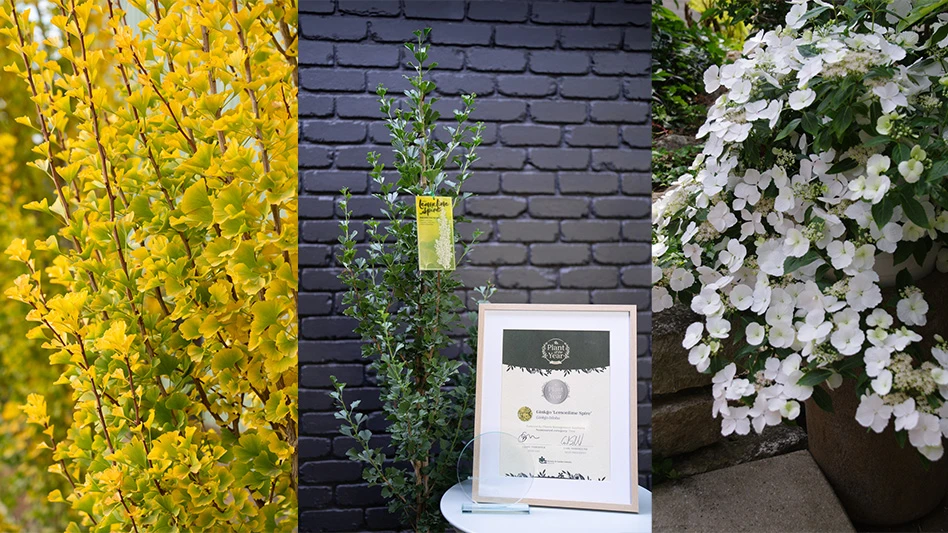 Diseases are a major concern for nursery and greenhouse growers and can be a key limitation to profitable plant production. Disease management in nurseries and greenhouses is critical because of the limited air circulation encouraged by tight spacing and constant irrigation. Furthermore, high humidity provides optimal conditions for reproduction of many fungal and bacterial pathogens. When disease management is neglected, pathogen populations build up and continue to increase as long as there is susceptible plant tissue available for infection and disease development. Infected plant tissue, infested soil, and pathogen inoculum all serve as sources of pathogens that can later infect healthy plants. Removal of any material that can harbor pathogens is the basis for disease management using sanitation practices. This prevents spread of pathogens to healthy plants or reduces survival from one cropping cycle to another.
Diseases are a major concern for nursery and greenhouse growers and can be a key limitation to profitable plant production. Disease management in nurseries and greenhouses is critical because of the limited air circulation encouraged by tight spacing and constant irrigation. Furthermore, high humidity provides optimal conditions for reproduction of many fungal and bacterial pathogens. When disease management is neglected, pathogen populations build up and continue to increase as long as there is susceptible plant tissue available for infection and disease development. Infected plant tissue, infested soil, and pathogen inoculum all serve as sources of pathogens that can later infect healthy plants. Removal of any material that can harbor pathogens is the basis for disease management using sanitation practices. This prevents spread of pathogens to healthy plants or reduces survival from one cropping cycle to another.
Importance of sanitation
Reduction of fungal and bacterial pathogens by various sanitation practices can reduce both active and dormant inoculum (infective pathogenic tissue). While actively growing plants can provide host tissue for pathogen multiplication and sporulation, dead plant material can harbor overwintering propagules (fungal spores and bacterial cells) for months or years. These propagules can travel through wind/fan currents, stick to shoes or tools, or move with contaminated soil or water droplets.
Sanitation is one of the most overlooked disease management practices. Often, growers presume that fungicides are the most important disease management tool at their disposal. However basic cultural practices such as sanitation help reduce pathogen numbers and eliminate infective propagules that cause disease. Poor sanitation practices allow pathogens to spread to healthy plants or to survive from one cropping cycle to another. Elimination and reduction of pathogens can help prevent “overwhelming” of spray programs in which surviving propagules cause disease epidemics within greenhouses.
Sanitation should be considered by both conventional and organic growers.
Start with prevention
 It may sound ingenuous, but the idea of starting with clean plants is essential. Often, diseases are introduced through shipments of liners and starter plants. Greenhouse and nursery managers should inspect shipments immediately upon delivery. Early disease symptoms that occur on lower branches and inner canopies can be overlooked, so a careful examination is necessary. Roots should also be inspected for healthy color and distribution. Unhealthy plants, especially those with disease symptoms, should be rejected.
It may sound ingenuous, but the idea of starting with clean plants is essential. Often, diseases are introduced through shipments of liners and starter plants. Greenhouse and nursery managers should inspect shipments immediately upon delivery. Early disease symptoms that occur on lower branches and inner canopies can be overlooked, so a careful examination is necessary. Roots should also be inspected for healthy color and distribution. Unhealthy plants, especially those with disease symptoms, should be rejected.
It is recommended that new plants are isolated for up to three weeks for monitoring. This is especially true for plants at risk for invasive (e.g. boxwood blight and impatiens downy mildew) or lethal diseases (e.g. bacterial wilts). Once a disease begins to spread through a production facility, it can be difficult to manage.
Disease management
Elimination and/or reduction of pathogens from greenhouses and nurseries results in fewer fungal propagules. Growers should be familiar with the most common diseases of the plants they grow. An understanding of the basic biology of the pathogens that cause them helps with the prediction of spread and severity. Evaluation of previous seasons’ disease dilemmas and of nearby outbreaks is a key to predicting current risk. Next, growers should scout on a regular basis. Early identification of disease symptoms often allow for ample time to manage disease before significant yield losses occur.
 The following sanitation practices can reduce amounts of infectious pathogens.
The following sanitation practices can reduce amounts of infectious pathogens.
- Discard plants that are heavily infected and those with untreatable diseases (e.g. root rots and black root rot).
- Some diseases (e.g. leaf spots and powdery mildew) can be managed using fungicides; isolate infected plants until disease is eliminated. Fungicides won’t bring dead tissue back to life, but using fungicides will help protect new growth, allowing plants to overcome disease outbreaks.
- Stem cankers should be removed about 6 inches below diseased wood or at a branch’s point or origin. Proper pruning cuts are critical for rapid healing.
- If infected plants are to be treated with fungicides, prune or remove infected tissue (flowers, leaves) to eliminate sources for spore production or propagule multiplication before fungicide application.
- Discard prunings and culled plants. Never leave cuttings in greenhouses, as pathogens may continue to multiply by producing spores or other propagules. Do not compost cuttings or soil because incomplete composting (temperatures below 160° F may result in survival of propagules.
- Remove weeds and volunteer plants to prevent establishment of a “green bridge” between crops. A green bridge allows pathogens to infect alternate hosts until a more suitable one becomes available.
- Do not reuse soil or potting media. Do not bring outside soil into greenhouse or nursery production areas. Use sterilized potting mix only.
- Disinfest pots, benches, floors, and tools to remove spores and propagules. Use a commercial disinfectant such as Green-Shield, 10 percent bleach, or 10 percent Lysol concentrated disinfectant. Note: bleach is corrosive, so tools must be rinsed after 5 to 10 minutes of exposure.
- Clean excess soil and plant debris from floors and benches. Soilborne pathogens can remain dormant in soil for months or years, becoming infective when temperature and humidity increase or when susceptible plant material becomes available.
- Do not drag hoses and other tools along floors, where infested soil and plant debris can stick and be moved to clean surfaces.
- Ideally, a sanitation regime should begin with an empty greenhouse or a clean nursery block. Clean and sanitize all surfaces to insure that pathogens are not carried over from one season to the next.
- Use foot baths containing sanitizers in greenhouses to prevent carrying propagules to clean areas.
- Restrict traffic to and from nursery areas, especially if invasive or easily transmissible diseases have been identified in the vicinity.
Continuing education
An effective disease management program must include sanitation as a major component. By understanding the pathogens that cause disease, growers are better able to manage them. Establishing a relationship with local extension agents or extension educators can help build a solid knowledge base. Educational sessions, pest alerts, and regionally-specific publications are often available to growers at no charge or for a minimal fee.
Finally, growers should insure that all employees are properly educated in pest and disease management practices. Even the most esteemed facilities can only be as strong as their weakest link.Sanitation and other disease management practices should be displayed in common areas and included in employee handbooks.
Dr. Nicole Ward Gauthier is an extension specialist in the Department of Plant Pathology at the University of Kentucky. She is responsible for outreach and research of diseases of ornamentals and fruit crops across the state. Her publications can be found at www2.ca.uky.edu/agcollege/plantpathology/people/ward.htm.

Explore the July 2014 Issue
Check out more from this issue and find your next story to read.
Latest from Nursery Management
- Hoffman Nursery announces David Hoffman as CEO, Craig Reynolds as COO
- The next 100 years
- National Garden Bureau announces 2025 Green Thumb Award winners
- Applications now open for American Floral Endowment graduate scholarships
- A nation of gardeners
- Get to know James Saunders
- Century city
- Research begins on Phytophthora austrocedri





